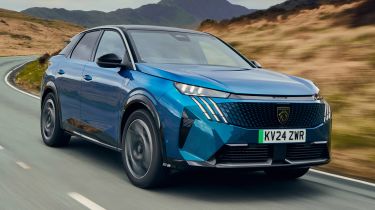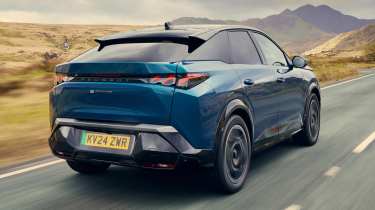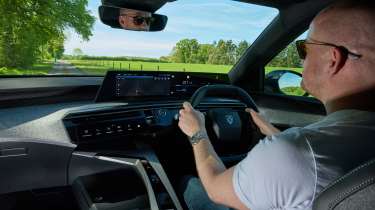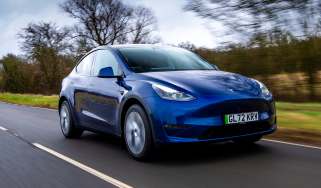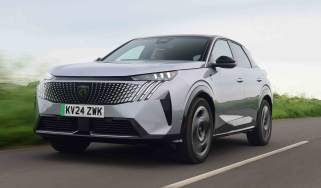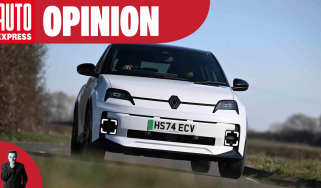New Peugeot E-3008 2024 review: fails to stand out from the EV crowd
The new Peugeot E-3008 looks the part, but is held back by disappointing performance and a harsh ride

Verdict
The new Peugeot E-3008 is a spacious, efficient EV with a stunning cabin design. But that aside, the newcomer does little to move the game on. Performance is sub-par, while ride comfort disappoints. It’s by no means a bad car, but given the significance of the E-3008 both for Peugeot and the entire Stellantis group, we were hoping for more. Strong finance deals rescue what would’ve otherwise been a lower score.
This is the all-new Peugeot E-3008, and it’s our first chance to get behind the wheel in the UK, of what is one of the brand’s most significant new models in years.
There’s a huge amount riding on it. Firstly because of the hugely competitive class that it wades into. All-electric models like the Skoda Enyaq, Tesla Model Y and Renault Scenic E-Tech are all fighting for class supremacy. The 3008 also launches with a hybrid powertrain (a PHEV will follow) so you can count the Hyundai Tucson, Kia Sportage and Nissan Qashqai as rivals, too.
But even more significant is the fact this is a car that will set the stall out for the future models of not just Peugeot, but the entire Stellantis empire. The E-3008 is the first of many upcoming cars to use the group’s latest STLA (pronounced ‘Stella’ for convenience) architecture. There’s a lot riding on this car, then.
Used - available now
It has some eye-catching specs. Peugeot claims that the long-range E-3008 with the bigger battery (due later) will be able to cover up to 422 miles on a single charge. However, Peugeot says that even the launch model that we’re driving here, with a smaller 73kWh battery, covers 326 miles on a charge – very close to the top-spec Skoda Enyaq’s 348-mile maximum. You can thank the Peugeot’s efficiency for that; WLTP numbers suggest the E-3008 can hit 4.6 miles per kilowatt-hour.
Charging is decent, too. At 160kW, the E-3008 is above average for the class, pipping the all-new Scenic (150kW) if not quite matching the rapid rates of the Model Y and Hyundai Ioniq 5. A new E-Routes feature can calculate the optimum route on a longer trip by considering the distance, available range, charge-station locations and traffic conditions to make the journey as easy and efficient as possible. E-Routes is accessible through a mobile device connected to the new infotainment system.
The in-car tech set-up is similar to the system used in the 308 hatchback, with customisable shortcut widgets on a secondary touchscreen making it easy to work with. Unlike in its hatchback sibling, however, the 3008’s screen forms a single 21-inch display that flows into the main driver instrument cluster, which appears to float above the dash.
Beneath it there’s Peugeot’s signature small steering wheel, which we had no issues with here (some drivers find that the wheel can obstruct the digital driver’s display in other Peugeots), and a dashboard that swoops dramatically around the driver to form a sporty and luxurious feel. It’s unlike anything else in the segment, and the use of materials, ambient lighting and contemporary design make it class-leading. Passenger space is great, too, and the 520-litre boot is more than big enough.
As long as you’re not moving, then, the E-3008 is an impressive car. Unfortunately, the driving experience doesn’t live up to expectations.
The E-3008 single motor makes 207bhp and 345Nm. Not outstanding figures, and so it proves on the road. Performance is sprightly enough below 30mph, but the acceleration tails off significantly as you approach motorway speeds. This will be addressed by a more potent dual-motor model with 316bhp, joining the range at a later date.
But more power won’t fix the chassis’ flaws. Even from low speeds, the steering is odd, with a sticky sensation just off centre. In sport, it gets heavier and even more gloopy.
It feels agile enough through corners and there isn’t much body roll, but that’s because the ride is far too firm for a car of this type. On a country road it thumps strongly into every compression and around town it fidgets over broken surfaces. Refinement is strong, through, with road and wind noise well-suppressed from the inside. We’re also big fans of the introduction of steering-wheel mounted paddles to access three levels of brake regeneration on the fly.
There are alternatives that ride and/or handle better; it just feels like Peugeot’s engineers weren’t really given the opportunity to do their best work. And given the significance of this car for the French manufacturer, that’s a big shame.
We never quite managed to match Peugeot’s efficiency claims, but 4.2mi/kWh away from motorways translates into a still-impressive 307-mile range. But the fact that a heat pump is a £700 optional extra is disappointing.
The E-3008 starts from £45,850 in Allure trim, the lower of two trim levels. Equipment is fairly strong, but if you want the likes of front parking sensors, adaptive cruise control, heated front seats and ambient lighting and more, you’ll need the £49,650 GT.
Zero per cent finance and a £500 deposit contribution makes it competitive on finance, though. Place a £5,000 deposit on a three-year PCP agreement with a 10,000-mile annual limit, and the GT model comes to £529 a month. On matching terms, the more powerful Renault Scenic E-Tech (which gets a standard heat pump) costs £580 per month.
| Model: | Peugeot E-3008 GT 73kWh 210 |
| Price (from): | £45,850 |
| Price (as tested): | £49,650 |
| Powertrain: | 1x e-motor, 73kWh battery |
| Power/torque: | 207bhp/345Nm |
| Transmission: | Single speed, front-wheel drive |
| 0-62mph: | 8.8 seconds |
| Top speed: | 105 mph |
| Range: | 326 miles |
| Charging: | 160kW (20-80% in 20 minutes) |
| Size (L/W/H): | 4,542/1,895/1,641mm |
| On sale: | Now |

